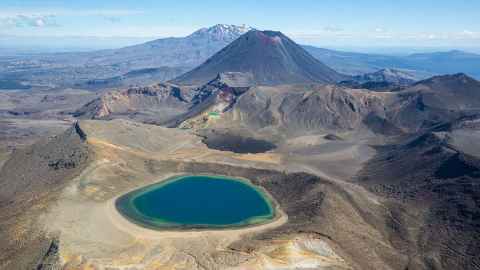Little regard for Māori heritage
30 November 2020
Opinion: There is an ongoing struggle to address Te Āo Māori in how we see, understand and protect our past and land-based heritage. Nicola Short explains.

Māori heritage is the oldest and rarest we have in Aotearoa New Zealand, but it is given little regard on the country’s official list that identifies our most significant historic heritage places. Instead, the New Zealand list, produced by government agency Heritage New Zealand Pouhere Taonga, is heavily weighted in favour of Pākehā heritage, reflecting the values of those who control it.
Currently, less than 10 percent of the list identifies Māori heritage and around 80 percent of the list is comprised of buildings. This disparity is not surprising as the development of heritage, here and internationally, has been driven traditionally by European notions of what is of heritage value – typically buildings, monuments and the work of important architects.
However, since the 1990s there has been a significant move away from the colonising Eurocentric view of heritage in other parts of the world. The United Nations 1994 Nara Declaration and the 2004 Natchitoches Declaration recognised the importance of indigenous heritage and encourages the inclusion of multiple voices in our understanding of heritage. These declarations seek to find more balanced ways of identifying and protecting greater diversity in the range and scope of heritage places, to balance aesthetic visual values with other values such as spiritual importance.
In 1992, ‘cultural landscapes’ were formally recognised as world heritage places. A cultural landscape approach allows for a more holistic approach to our pasts and places, and recognises that people’s connection to them has multi-layered, multi-cultural, natural, tangible and intangible values. Importantly, cultural landscapes recognise Indigenous/Māori relationships to whenua (land), in which cultural and natural values are integrated and entwined.
Unfortunately, this shift towards a more encompassing view of heritage has not yet had a significant influence on heritage practice in Aotearoa. This is surprising given that the first cultural landscape to become a world heritage site was Tongariro National Park in 1994.
The current lack of national support in our legal frameworks for cultural landscapes represents the ongoing struggle to address Te Āo Māori, and how we as a country see, understand and protect our past and land-based heritage.
The results of not including cultural landscapes as a heritage type can be seen at Ihumātao, where the recognition of heritage values has challenged the current approach. The upgrading of the listing and, more importantly, the inclusion of the at-risk land blocks earlier this year has gone some distance in recognising the importance of the place. The full range of cultural landscape values, particularly Māori heritage values, are still not recognised though.
The relentless emphasis on buildings, evident in both Heritage New Zealand Pouhere Taonga protection list and current policy initiatives by central government agencies responsible for heritage, reflects the dominance of Pākehā culture. This was balanced somewhat in Waitangi Settlements when, for example, recognition of legal personhood was afforded to Te Urewera.
However, when it comes to heritage, cultural landscapes remain unprotected. This challenges the relevance of the current heritage regime for Māori. If it is only through a separate legal process that Māori heritage can be protected, who is the existing heritage system for? And what about te Tiriti obligations?
There have been attempts to change the legislative framework of Aotearoa to take account of heritage in more diverse and inclusive ways, but they have been unsuccessful. Cultural landscapes were removed from amendments to the Resource Management Act (RMA) in 2004 and 2013, as well as from the text of the Heritage NZ Pouhere Taonga Act 2014 in its final reading. This was justified on the basis that cultural landscapes were covered by the amenity values (visual appeal) and the maintenance and enhancement of the quality of the environment.
But seeing heritage as primarily about visual and tangible values does not recognise the contribution our heritage places make to national identity and a sense of place and undervalues the role of the past in both the present and our futures.
Furthermore, the legal and policy frameworks' bias towards eurocentric heritage and buildings is reflected in current funding arrangements. There are stark imbalances in government funding, possibly the most powerful tool available to protect heritage, and capital is primarily targeted to celebrating and protecting the largely Pākehā architectural canon.
For example, in 2019 about $38.5m was spent on cultural heritage places by central government. Two percent of this spend went on Māori land-based heritage; built heritage projects made up the remaining 98 percent. It is great that there is support for heritage buildings, but the current approach demonstrates a significant and damaging imbalance.
So how can heritage decision making better align with the nation’s past and responsibilities under Te Tiriti o Waitangi?
We first need to talk about how heritage is ‘done’ in Aotearoa. There needs to be a discussion and actions taken to ensure greater equity for Māori heritage in policy reform, decision-making, and funding arrangements. An appropriate framework for this discussion is through a cultural landscape lens.
Let’s not repeat the mistakes of the past and focus heritage just on pretty things. The Randerson Report on Resource Management Act reform (2020) recommended the inclusion of cultural landscapes as a form of heritage. While not a new idea, if the Crown is serious about honouring the nation’s partnership foundations the time for cultural landscapes has come.
Nicola Short sits on the Heritage Advisory Panel for Auckland Council and is a Heritage Consultant. Follow @heritagenzfutures
Nicola Short is a heritage consultant, lecturer and doctoral candidate in the Department of Architecture and Planning.
This article reflects the opinion of the author and not necessarily the views of the University of Auckland.
Used with permission from Newsroom Little regard for Māori heritage 30 November 2020.
Media queries
Alison Sims | Research Communications Editor
DDI 09 923 4953
Mob 021 249 0089
Email alison.sims@auckland.ac.nz